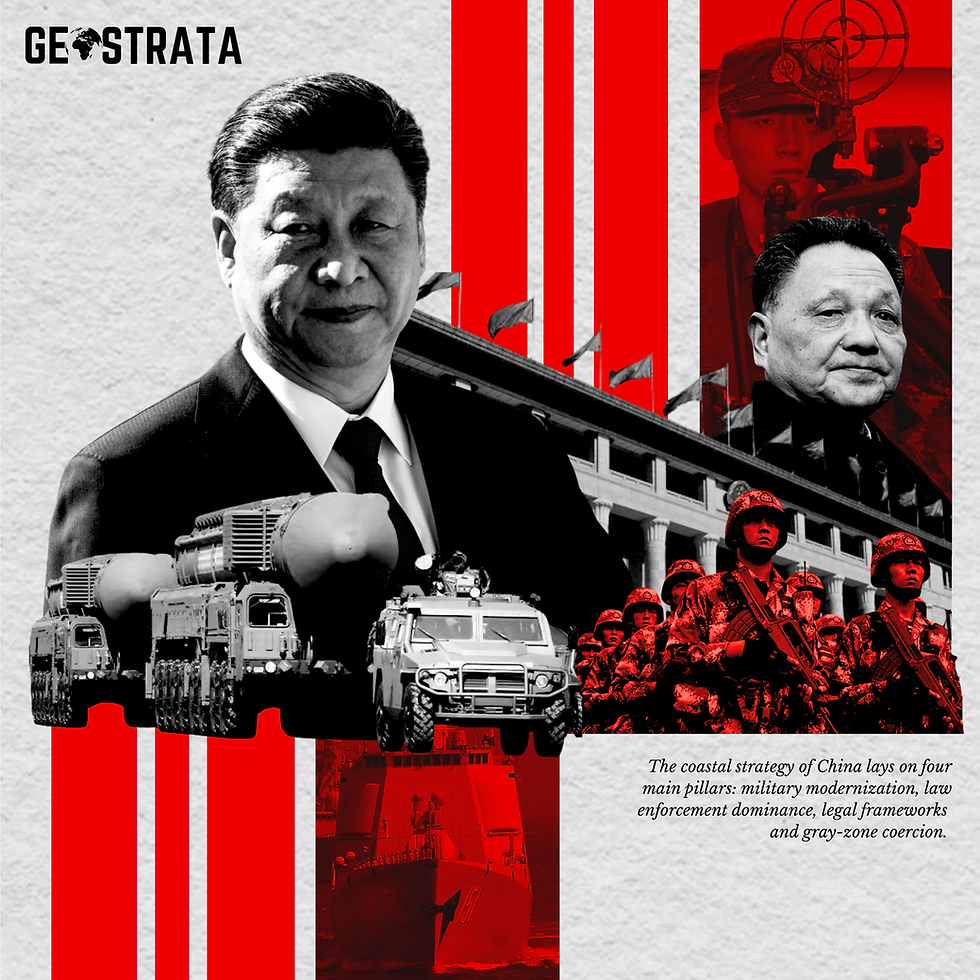Clausewitz in Kashmir: Understanding the Kashmir Conflict Through Classical Strategy
- THE GEOSTRATA

- May 9
- 4 min read
Updated: Aug 9
Carl Von Clausewitz, a Prussian General, wrote On War in the 19th Century, hardly imagining a region like Kashmir—a land caught in an endless crossfire between nuclear-armed nations. Kashmir is shaped as much by its landscape as by its history—a history whose silence deafens the valley with its convoluted violence and politics.
Illustration by The Geostrata
In Kashmir, Clausewitz’s principle that “war is merely the continuation of politics by other means” is not just a philosophical review, but a continued actuality.
Post 1947, the valley became a grandstand where Clausewitz’s ideas found symbolism in the political mystique of the region- with constant standoffs, cross-border insurgency and strategic structure, predetermining the obscurity of both Indian and Pakistani procedures.
THE POLITICAL OBJECT AND THE NATURE OF WAR IN KASHMIR
Clausewitz in his literature predicates that war must satisfy a political object. In the case of Kashmir, the conflict holds centre in the partition of the two nations, based on religious distinctions, where, according to Pakistani understanding, Kashmir, a Muslim majority region but ruled by a Hindu Maharaja, should have joined it. Whereas for India, the region symbolised secular nationalism, proving that India’s nationhood wasn’t based on religion, a beacon of Nehruvian ideology.
This being comprehended, Clausewitz warns that if the central object loses orientation, the conflict adopts a sense of vagueness and incessance.
Over the years, the diplomatic rationales of both the nations have evolved – from regional dominance to ideological influence – further complicating the nature of the conflict. At present, the conflict in Kashmir is no longer just a territorial dispute; it is a multidimensional battle with contested narratives.
FRICTION AND FOG OF WAR IN THE HIMALAYAS
On War introduces the concept of friction- talking about the numerous entities that complexify warfare. In the context of Kashmir and the Himalayan region, the harsh terrain acts as a definite representation. Warfare in high altitudes like Kargil and Siachen not only test the endurance of our soldiers but also the extent of our military’s command and logistics.
“The fog of war”- is Clausewitz’s metaphor to describe the ambiguity inherent in the nature of combat, which in the case of Kashmir adds strategic depth. Elements like misinformation, non-state actors and shifting allegiances amongst locals contribute to the narrative that fogs intention and amplifies suspicion.
ESCALATION AND THE BALANCE OR RISK
Clausewitz saw war as a “paradoxical trinity” composed of primordial violence, chance, and rational policy. In Kashmir, this trinity ceaselessly oscillates. Incidents like the 2016 Uri attack, succeeded by the surgical strikes and the 2019 Pulwama IED attack followed by the Balakot airstrikes, as well as the recent Baisaran Valley attack which subsequently gave way to Operation Sindoor- are contemporary replications of this Clausewitzian balance.
Rational state policy is entangled with the chaos of violent provocations and the unpredictable nature of its escalation.
Clausewitz crucially argued that the intensity of war depends on the stakes involved. In a nuclear setting, full-scale war becomes an improbable game of chance, giving way to “grey zone” warfare. In Kashmir, this has taken the form of cross-border firing, cyber operations, information warfare, and the use of militants as strategic tools—a chessboard where violence is calibrated rather than unleashed wholesale.
THE WILL OF THE PEOPLE OF THE MORAL FORCES
According to Clausewitz, the spirit, will and cohesion of the people play a determining role in war- in Kashmir these forces are deeply fractured, causing alienation and dissent in local sentiment and dampening their aspirations of independence or autonomy and reaction towards security operations form a contested emotional and psychological terrain. For India- holistically steering the Kashmiri spirit isn’t a soft strategy but a core Clausewitzian goal.
Pakistan continues to use Kashmir as a point of domestic political discourse creating complications in rational policy making, while completely leaving the diaspora of Pakistan occupied Kashmir out of the equation.
CLAUSEWITZ 'S RELEVANCE IN THE ERA OF STRATEGIC PATIENCE
Despite his theory being set in the 19th century, Clausewitz remains a relevant figure which has helped understand conflicts through structured frameworks. He reiterates that political logic must be the fore-runner, with a strong military foundation. However in Kashmir, military escalations have often preceded political consensus.
In 2019, the decision to abrogate article 370 was seen as a strategic move with great political implications.
Whether this decision will contribute to long-term stability or trigger a new wave of resistance is yet to be unfolded. Either way, Clausewitz would caution that if politics does not define the objective clearly, even the most decisive military actions may not lead to enduring peace.
In all this complexity, Kashmir stands as a textbook case of Clausewitz’s ideals. A conflict where war serves politics, its friction moulds outcomes and where rational policy meets irrational passions.
Clausewitz’s lens may not provide solutions, but it sharpens our comprehension of the conflict- and why simplistic approaches whether militaristic or utopian, are bound to fail.
Carl von Clausewitz may never have seen the Himalayas, but his ghost walks the valleys of Kashmir, whispering that war, in all its forms, must ultimately answer to politics—and that without clarity of purpose, the guns may fall silent, but peace will remain elusive.
BY AAVRITI CHAUHAN
TEAM GEOSTRATA
.png)








Comments